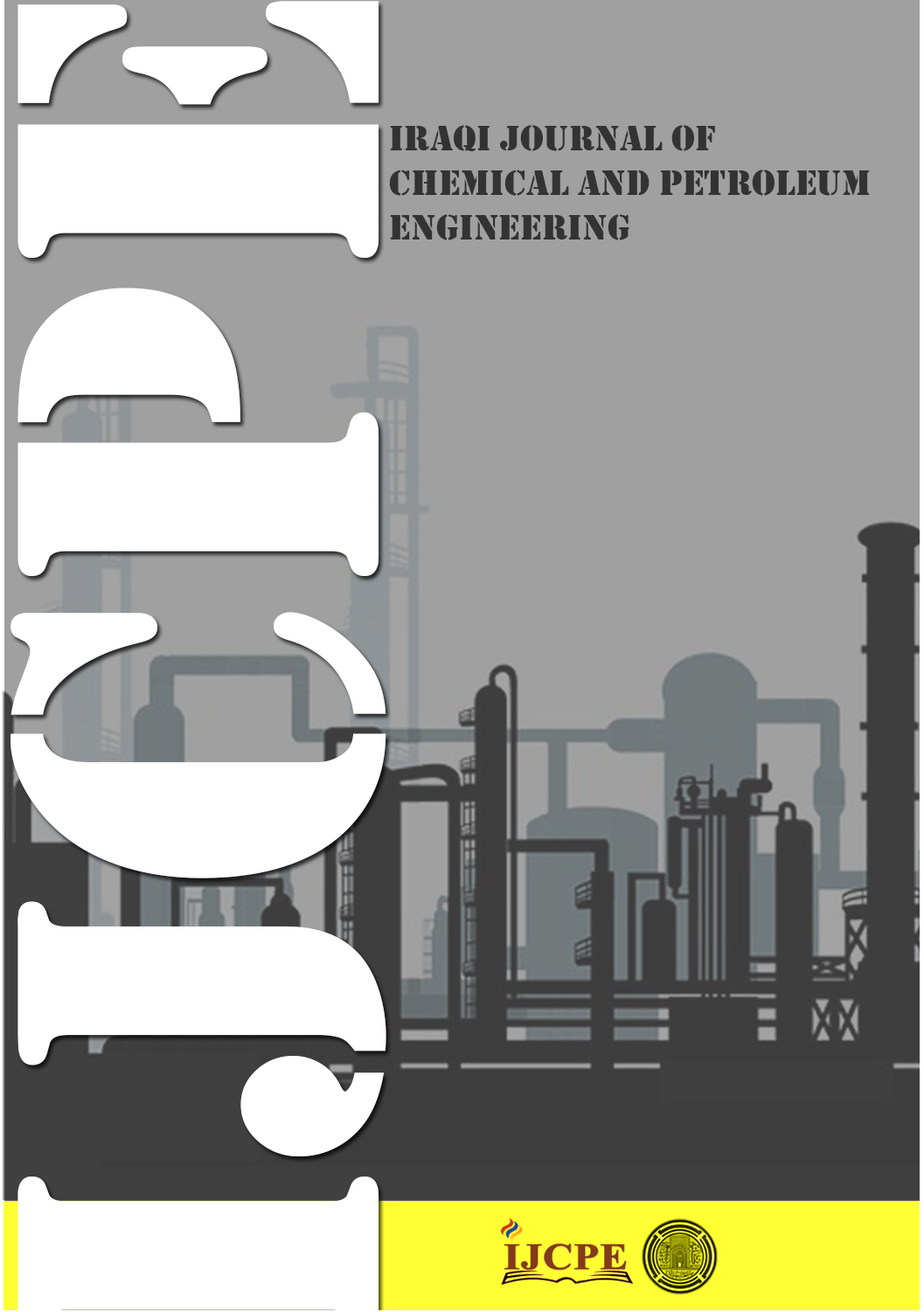Influence of PVA on wettability alteration of carbonate rocks: the role of different ions
DOI:
https://doi.org/10.31699/IJCPE.2025.3.4Keywords:
Polyvinyl Alcohol (PVA); Wettability Alteration; Brine; Contact Angle; Surface Tension; Interfacial TensionAbstract
The petroleum industry faces a significant problem in enhanced oil recovery (EOR) from carbonate reservoirs because of their mostly oil-wet character, which restricts hydrocarbon extraction. To better understand how surfactant-polymer techniques can enhance oil recovery, this study investigates the effectiveness of polyvinyl alcohol (PVA) as a stand-alone agent and the function of ionically modified smart water on carbonate properties. The study focuses on its effect on critical parameters essential for effective oil displacement and recovery, such as wettability alteration, interfacial tension, and surface tension (ST) using different brines (smart water). The ability of the polymer PVA to lower interfacial and surface tension was investigated. PVA decreased surface tension in brine to 44 mN/m, although smart water solutions showed more noteworthy outcomes. When PVA was added to smart water with a 1:1 Mg²⁺/SO4²⁻ ratio, the lowest ST (29 mN/m) and IFT (11.8 mN/m) values were observed. The hydrophilic properties of PVA and its ionic interaction with Mg²⁺ were key factors in encouraging water adsorption on the surface of the carbonate rock. The contact angle was getting closer to zero, indicating that this interaction resulted in a full transition to a water-wet condition. Enhancing the oil displacement process in carbonate reservoirs—generally refractory to recovery—requires this complete transition to water-wet conditions. This full shift to water-wet conditions is vital for enhancing the oil displacement process in carbonate reservoirs, which are typically resistant to recovery due to their oil-wet surfaces.
Received on 16/11/2024
Received in Revised Form on 28/12/2024
Accepted on 28/12/2024
Published on 30/09/2025
References
[1] F. Civan, Reservoir Formation Damage. Elsevier, 2023. https://doi.org/10.1016/C2020-0-03547-4
[2] M. Mohammed and T. Babadagli, “Wettability alteration: A comprehensive review of materials/methods and testing the selected ones on heavy-oil containing oil-wet systems,” Advances in Colloid and Interface Science, vol. 220, pp. 54–77, Jun. 2015, https://doi.org/10.1016/j.cis.2015.02.006
[3] A. Z. Abidin, T. Puspasari, and W. A. Nugroho, “Polymers for Enhanced Oil Recovery Technology,” Procedia Chemistry, vol. 4, pp. 11–16, 2012, https://doi.org/10.1016/j.proche.2012.06.002
[4] I. Ilyasov, I. Koltsov, P. Golub, N. Tretyakov, A. Cheban, and A. Thomas, “Polymer Retention Determination in Porous Media for Polymer Flooding in Unconsolidated Reservoir,” Polymers، vol. 13, no. 16, p. 2737, Aug. 2021, https://doi.org/10.3390/polym13162737
[5] A. Gbadamosi et al., “Application of Polymers for Chemical Enhanced Oil Recovery: A Review,” Polymers , vol. 14, no. 7, p. 1433, Mar. 2022, https://doi.org/10.3390/polym14071433
[6] W. Li, Y. Yu, M. Lamson, M. S. Silverstein, R. D. Tilton, and K. Matyjaszewski, “PEO-Based Star Copolymers as Stabilizers for Water-in-Oil or Oil-in-Water Emulsions,” Macromolecules, vol. 45, no. 23, pp. 9419–9426, Dec. 2012, https://doi.org/10.1021/ma3016773
[7] O. S. Alade et al., “A novel technique for heavy oil recovery using polyvinyl alcohol (PVA) and PVA-NaOH with ethanol additive,” Fuel, vol. 285, p. 119128, Feb. 2021, https://doi.org/10.1016/j.fuel.2020.119128
[8] A. N. Awolayo, H. K. Sarma, and L. X. Nghiem, “Brine-Dependent Recovery Processes in Carbonate and Sandstone Petroleum Reservoirs: Review of Laboratory-Field Studies, Interfacial Mechanisms and Modeling Attempts,” Energies, vol. 11, no. 11, p. 3020, Nov. 2018, https://doi.org/10.3390/en11113020
[9] M. Kalbasi, K. N. Toosi, O. Arjmand, M. Kalbasi, and A. R. Roostaei, “Experimental Study of Chemical Flooding Using New Chemical Component to Enhance Oil Recovery,” Polymers, vol. 4, no. 17, pp. 3056–3061, 2012.
[10] R. R. Jalil and H. Q. Hussein, “The Influence of Nano Fluid Compared With Polyethylene Glycol and Surfactant on Wettability Alteration of Carbonate Rock,” Materials Science and Engineering, vol. 454, p. 012046, Dec. 2018, https://doi.org/10.1088/1757-899X/454/1/012046
[11] Z. Li, S. Ayirala, R. Mariath, A. AlSofi, Z. Xu, and A. Yousef, “Microscale Effects of Polymer on Wettability Alteration in Carbonates,” SPE Journal, vol. 25, no. 04, pp. 1884–1894, Aug. 2020, https://doi.org/10.2118/200251-PA
[12] K. Al-Busaidi, R. S. Al-Maamari, I. K. Al-Busaidi, and T. Divers, “Experimental investigation of wettability alteration of oil-wet carbonate surfaces using engineered polymer solutions: The effect of potential determining ions ([Mg2+/ SO42−], and [Ca2+/ SO42−] ratios),” Geoenergy Science and Engineering, vol. 230, 2023. https://doi.org/10.1016/j.geoen.2023.212182
[13] M. J. Rosen and J. T. Kunjappu, Surfactants and Interfacial Phenomena. Wiley, 2012. https://doi.org/10.1002/9781118228920
[14] A. Bhattacharya and P. Ray, “Studies on surface tension of poly(vinyl alcohol): Effect of concentration, temperature, and addition of chaotropic agents,” Applied Polymer Science, vol. 93, no. 1, pp. 122–130, Jul. 2004, https://doi.org/10.1002/app.20436
[15] A. Bhattacharya and P. Ray, “Studies on surface tension of poly(vinyl alcohol): Effect of concentration, temperature, and addition of chaotropic agents,” Applied Polymer Science, vol. 93, no. 1, pp. 122–130, Jul. 2004, https://doi.org/10.1002/app.20436
[16] B. Filova et al., “Effect of sodium salts on diffusion of poly(vinyl alcohol) in aqueous solutions,” Molecular Liquids, vol. 304, p. 112728, Apr. 2020, https://doi.org/10.1016/j.molliq.2020.112728
[17] O. S. Alade et al., “A novel technique for heavy oil recovery using poly vinyl alcohol (PVA) and PVA-NaOH with ethanol additive,” Fuel, vol. 285, p. 119128, Feb. 2021, https://doi.org/10.1016/j.fuel.2020.119128
[18] P. Sharma and P. Kumar Agrawal, “A Comprehensive Review on Properties of Polyvinyl Alcohol (PVA) Crosslinked with Carboxylic Acid,” Journal of Materials and Environmental Science, vol. 14, no. 10, 2023.
[19] D. Jahani, A. Nazari, J. Ghourbanpour, and A. Ameli, “Polyvinyl Alcohol/Calcium Carbonate Nanocomposites as Efficient and Cost-Effective Cationic Dye Adsorbents,” Polymers ، vol. 12, no. 10, p. 2179, Sep. 2020, https://doi.org/10.3390/polym12102179
[20] Saeed Rehana, Ashfaq Maria, and Mumtaz Amna, “Ionic Interactions of NaCl in Aqueous Polyvinyl Alcohol and Cross-Linked Polyvinyl Alcohol with Glutaraldehyde,” Scientific & Industrial Research, vol. 83, no. 6, Jun. 2024, https://doi.org/10.56042/jsir.v83i6.454
[21] S. Drexler, F. Hoerlle, W. Godoy, A. Boyd, and P. Couto, “Wettability Alteration by Carbonated Brine Injection and Its Impact on Pore-Scale Multiphase Flow for Carbon Capture and Storage and Enhanced Oil Recovery in a Carbonate Reservoir,” Applied Sciences, vol. 10, no. 18, p. 6496, Sep. 2020, https://doi.org/10.3390/app10186496
[22] Gbadamosi et al., “Application of Polymers for Chemical Enhanced Oil Recovery: A Review,” Polymers , vol. 14, no. 7, p. 1433, Mar. 2022, https://doi.org/10.3390/polym14071433
[23] R. A. Saari, M. S. Nasri, T. Kida, and M. Yamaguchi, “Impact of Magnesium Salt on the Mechanical and Thermal Properties of Poly(vinyl alcohol),” Polymers, vol. 13, no. 21, p. 3760, Oct. 2021, https://doi.org/10.3390/polym13213760
[24] W. Du, L. Jiang, M. Shi, Z. Yang, and X. Zhang, “The modification mechanism and the effect of magnesium chloride on poly(vinyl alcohol) films,” RSC Advances, vol. 9, no. 3, pp. 1602–1612, 2019, https://doi.org/10.1039/C8RA09958H
[25] B. Filova, L. Musilova, A. Mracek, M. L. Ramos, L. M. P. Veríssimo, A. J. M. Valente, and A. C. F. Ribeiro, "Effect of sodium salts on diffusion of poly(vinyl alcohol) in aqueous solutions," Molecular liquid, vol. 304, , pp. 112728, 2020, https://doi.org/10.1016/j.molliq.2020.112728
[26] B. Briscoe, P. Luckham, and S. Zhu, “The effects of hydrogen bonding upon the viscosity of aqueous poly(vinyl alcohol) solutions,” Polymer, vol. 41, no. 10, pp. 3851–3860, May 2000, https://doi.org/10.1016/S0032-3861(99)00550-9
[27] M. A. Ahmadi, M. Galedarzadeh, and S. R. Shadizadeh, “Wettability Alteration in Carbonate Rocks by Implementing New Derived Natural Surfactant: Enhanced Oil Recovery Applications,” Transport in Porous Media , vol. 106, no. 3, pp. 645–667, Feb. 2015, https://doi.org/10.1007/s11242-014-0418-0
Downloads
Published
Issue
Section
License
Copyright (c) 2025 The Author(s). Published by College of Engineering, University of Baghdad.

This work is licensed under a Creative Commons Attribution 4.0 International License.













